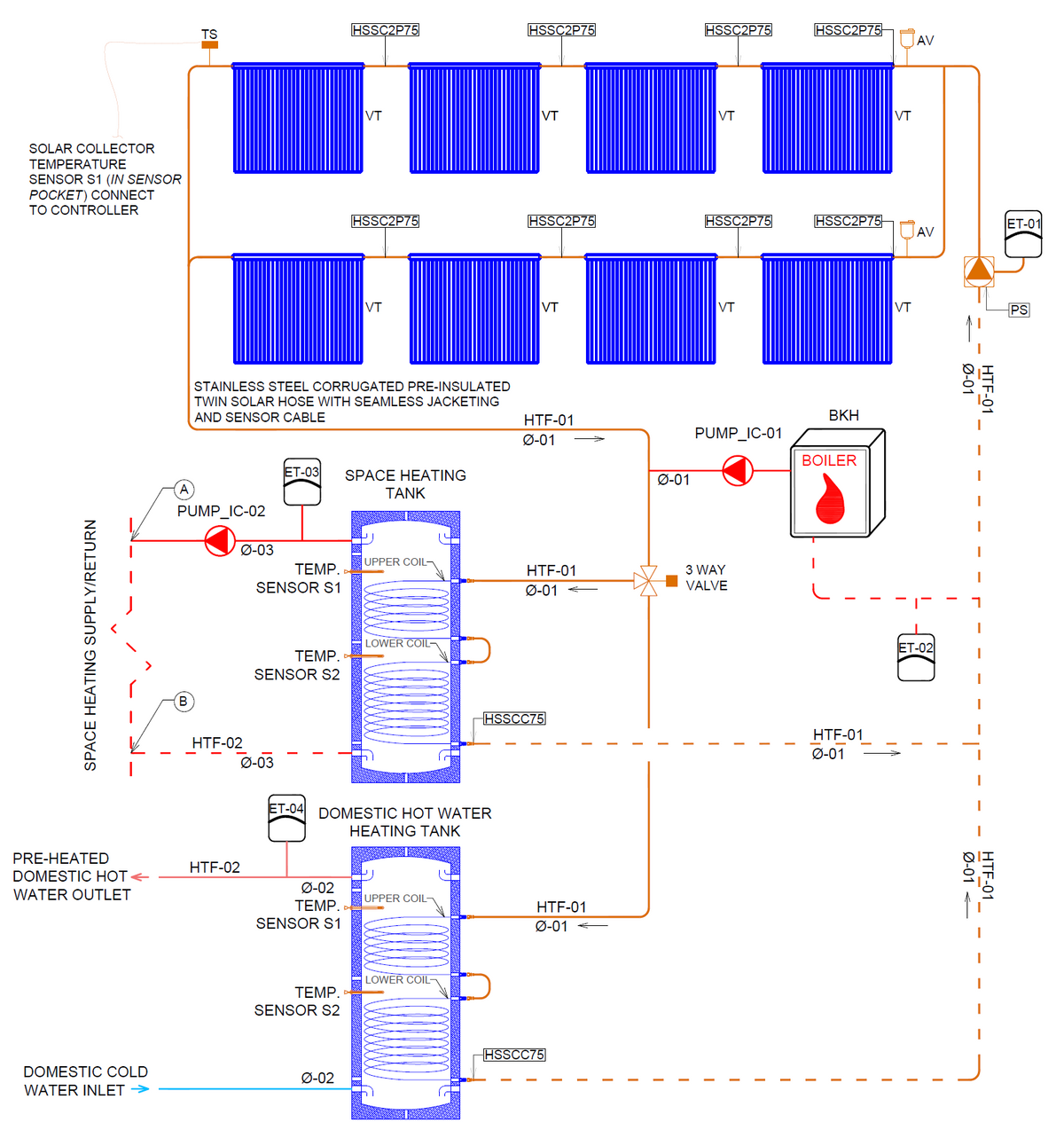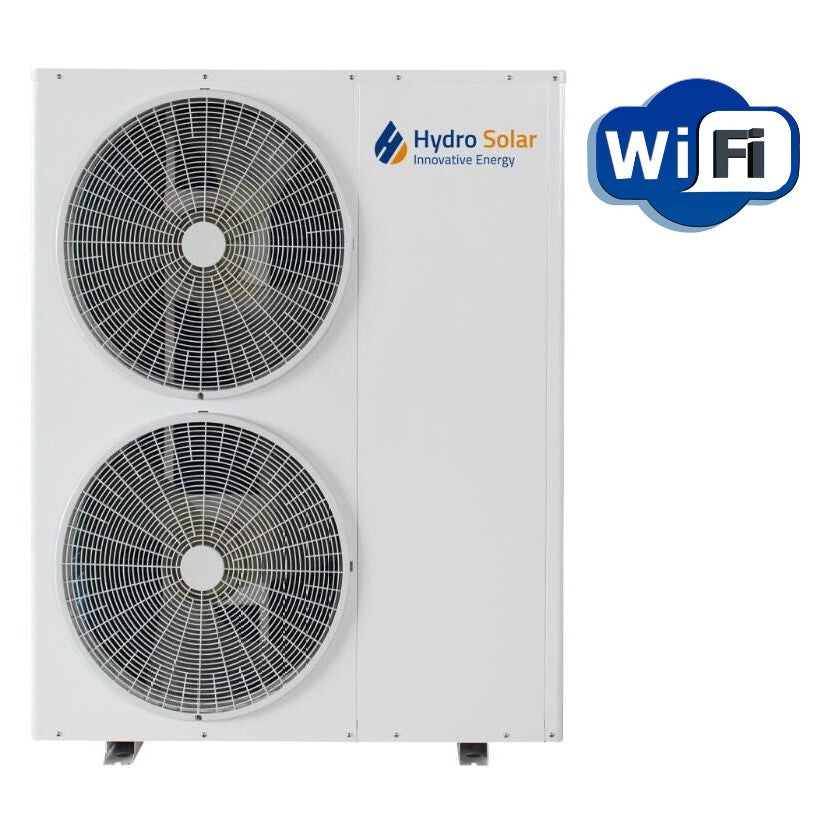How do Solar Thermal Heating Works?
How do Solar Water Heating Works?
Hydronic Heating with Solar is one of the Most Promising Solar Thermal Technologies, since water has been used for years in applications such as Space Heating, Space Cooling, Domestic Hot Water Heating, Pool/SPA heating, Industrial Process Heating, etc....

Introduction
Most major Canadian Cities, such as Toronto, Montreal, Winnipeg, Ottawa, Regina etc..., are spread along the Canada - US borders where solar insolation is at its peaks (when compared to the northern portion of the Canadian Map).
With almost eight months a year of buildings external envelope heating demand and a full year domestic hot water heating demand as well as other processes water heating (such as pools heating in the summer, industrial processes, etc...), solar energy is one of the most promising renewable energy for Canada.
This Blog will highlight how various Hydronic Solar Heating Systems work using Vacuum Tube Solar Collectors, since this type of Solar Thermal Panels do have a great performance in Canadian Winter when compared to other types of Solar Thermal Panels such as Glazed and Non Glazed Flat Plate Panels.
For more information about the Vacuum Tube Technology, we recommend reading the blog posts listed below:

How do Solar Thermal Water Heating Works?
Solar Thermal Panels (of all types) are simply heat exchangers. Evacuated Tubes Solar Collectors (Available is 15, 20, 25 and 30 tubes) absorb solar radiated energy and transfer the harvested solar energy into a fluid (Water, Polypropylene Glycol/Water mix or other type of fluids) that circulate in a closed loop configuration in order to heat other secondary fluid proper to the heating application (Water in the case of Domestic Hot Water (DHW) Heating, Air in the case of Hydronic Air Handling Unit, Chlorinated Water in the case of Swimming Pool, etc...).
In a typical Pressurized Polypropylene Glycol Solar Line configuration the immersed Coil will transfer the harvested solar heat into the Hot Water Storage Tank via the indirect immersed coil. In That Case the storage tank will be filled with water, heated indirectly by the hot glycol coming out from the outlet of the Evacuated Tube Solar Collector. This configuration is mostly used in cold climates and it works well in retrofit context where an electric or natural gas domestic hot water heater is already installed. In That case the Solar Hot Water Storage Tank will preheat domestic cold water before entering into the existing hot water heater.
In places heated with hydronic radiant floor heating, Solar Heat could be transferred to hydronic floor heating loops via the thermal storage tank. To do that, we recommend using dual coil tank with two inlets and outlets: the lower coil will be used to harvest solar energy collected by solar collectors and the upper coil will be used to transfer solar energy to hydronic heating loops while tank's main inlet and outlet could be used for DHW heating.
Most Common Solar Water Heater Configurations

- Split Solar Water Heating System, using a pressurized closed loop containing a Heat Transfer Fluid with an Anti-Freeze Solution (Usually Propylene Glycol Mix) when deployed in Nordic Climates
- Pressurized Drain Back System. Heat Transfer Fluid do need to have an anti-freeze solution in Nordic Climate since fluid will drain back to the tank (located indoor) when pump is turned off by solar controller.


This is a regular Split Solar Water Heating system with external heat exchanger (Usually Brazed Plate Heat Exchanger).
This Configuration is used residential and/or commercial retrofit projects, when an existing Domestic Hot Water Heater, Space Heating device (such as electric, Gaz or Propane Boiler) with existing thermal storage is existing.
In DHW heating application, This configuration is cheaper than the above two, however it's less efficient for the following reasons:
- Most Canadian and US Regulations require that DHW be Heat at 140 degree Fahrenheit. When Thermal Storage Tank is permanently maintained at 140F by back up heater, Vacuum Tube Solar Collector is at its lowest thermal efficiency since Evacuated Tube Solar Collectors thermal efficiency decreases when incoming fluid thermperature to the panel increases
- In Closed Loop Heating Applications, Pre-Heating Return with Hot Fluid produced by solar is not possible , which also reduces the savings generated by such as solar water heating system.
- Produced Hot fluid heating quality is reduced the Brazed Plate Heat Exchanger due to friction loss and temperature loss at the heat exchanger level.
- Electrical Power consumption is higher since this system requires two circulation pumps
Most Common Solar Water Heating Applications
Solar Water Heating Applications are the same as water heating applications, in which water or fluid of water and other fluid mixture are heated, to either provide thermal comfort (space heating with either infloor heating, forced air heating, Swimming Pool Heating, Process Heating and multiple other applications).
Due to the time gap between availability of solar radiation and demand for hot water (regardless of its application), each hydronic solar system requires a kind of thermal storage in form of water tank (daily storage) or underground seasonal thermal energy storage (thermal pit).
Our Solar Water Tank are designed in order to accommodate more than one application including a secondary or tertiary source of heat in order to increase system reliability and to offer customer one or two level of redundancy when solar energy is absent for longer period of time (consecutive winter days without sun).
Below are some schematics that combines domestic hot water heating, space heating, pool/SPA heating with the backup heat offered by either Air to Water Heat Pump and/or Boiler:
2 x 30 Tubes Panel Kit with Tank and accessories
This our Best Selling Kit. Air to Water Heat Pump and/or Titanium Heat Exchanger for swimming pool can be connected to either the second inlet/outlet set of the tank or on the solar glycol line respectively.
This kit is primarily used for space heating, however for application with DHW heating dominants load, DHW heating and Space Heating connections can be swapped.
When more than one panels are connected to single tank and when Heat Production in the summer exceed heating demand, Swimming Pool and or SPA can be used to dump excess heat.
4 x 30 Tubes Panel Kit with Tank and accessories combined with Air to Water Heat Pump
This is a more common kit for modern homes where outdoor temperature in winter does not fall below the minimum operating temperatures of Air to Water Heat Pump (-25C).
This kit is designed for the Maritimes since the majority of homeowners do not have access to cheap natural gas (as in Ontario and Alberta) and electricity rates are very expensive.
In this kit the primary source of heat for space heating and Domestic Hot Water Heating is Evacuated Tube Solar Collectors and Air to Water Heat Pump replaces the electric boiler (back up heat).

For Further Reading:
- Air to Water or Geothermal Heat Pump? Which one brings more value to your building?
- How Vacuum Tube Solar Collectors can help lengthen geothermal wells lifespan?
- Why and How Solar Thermal Systems underperform?
- Why and When Closed Loop Horizontal Geothermal Systems fail in Canadian Winter?
- Rules of Thumb for sizing a Domestic Hot Water Heater
- Taking your life off-grid






Can PVC piping be used to run the vacuum system for swimming pool? We have 100 tubes, 20 x5 panels
Hello,
I have a question if I could connect my slab hydronic heating to a upper coil as a buffer since I will be using glycol.
I am actually looking to do the exact same thing with a greenhouse so I would love similar information. Thank you.
Hello, I have a request that may sound naive or unusual. I am wondering if I could use solar to heat a greenhouse. This greenhouse is in the planning stage and it would run 9 months or 12 months a year if solar heating was good enough to keep the greenhouse above freezing. The greenhouse would be designed following a technique that is called a solar greenhouse. it has insulation on the north wall and is designed for solar heat gain. My thought was this design could be upgraded by having a solar radionic heating system. My hope is to put the radiant floor tubing in crushed stone of some sort instead of concrete. Is this possible? Do you have customers heating reenhouses using solar?
Thank You
Barry